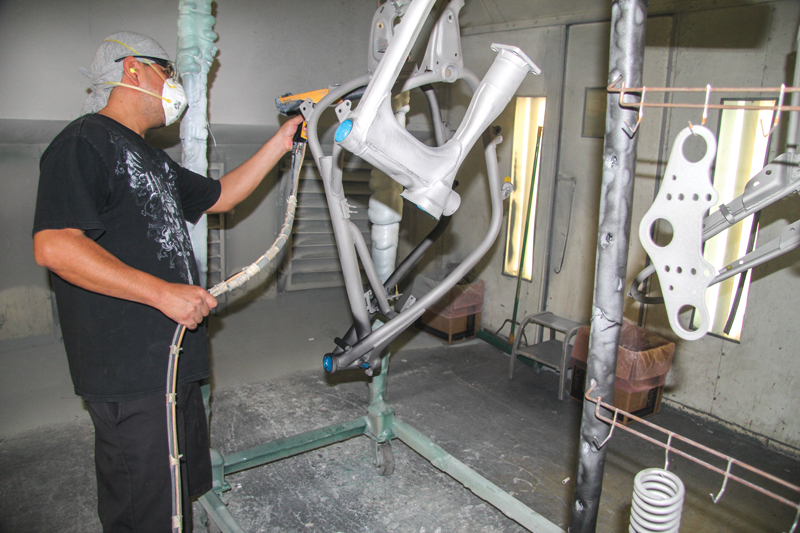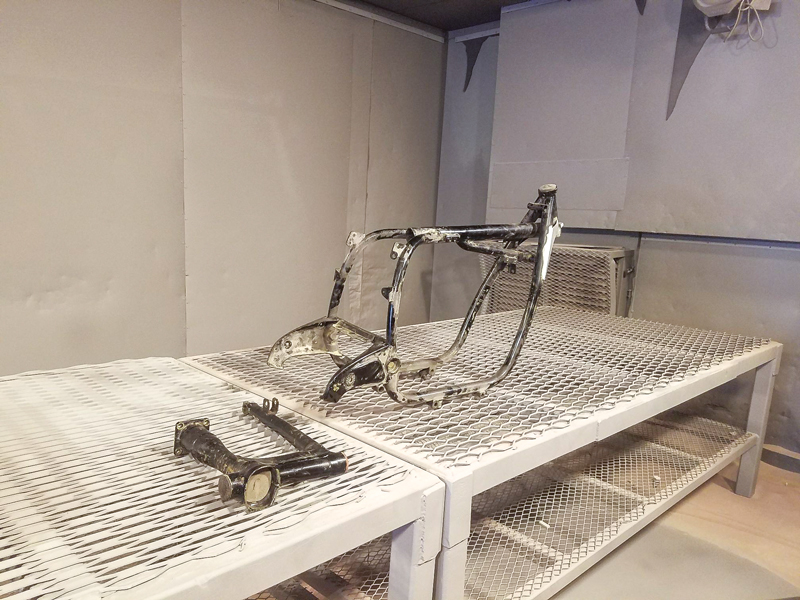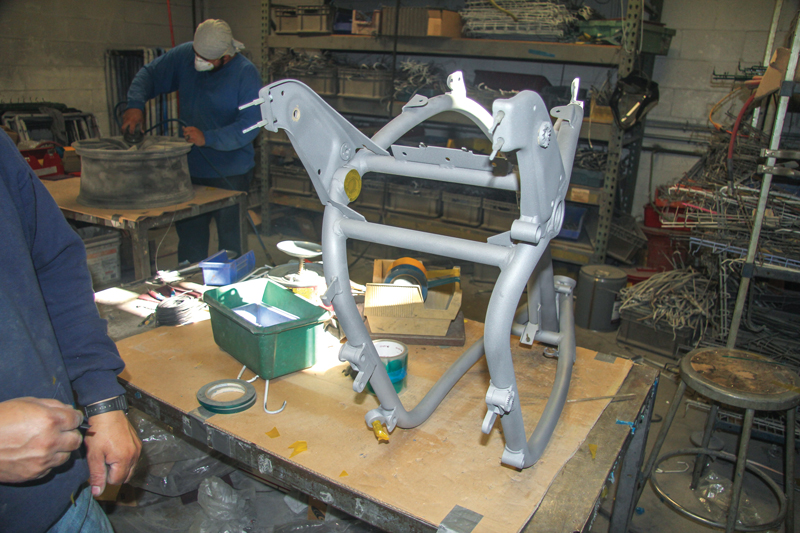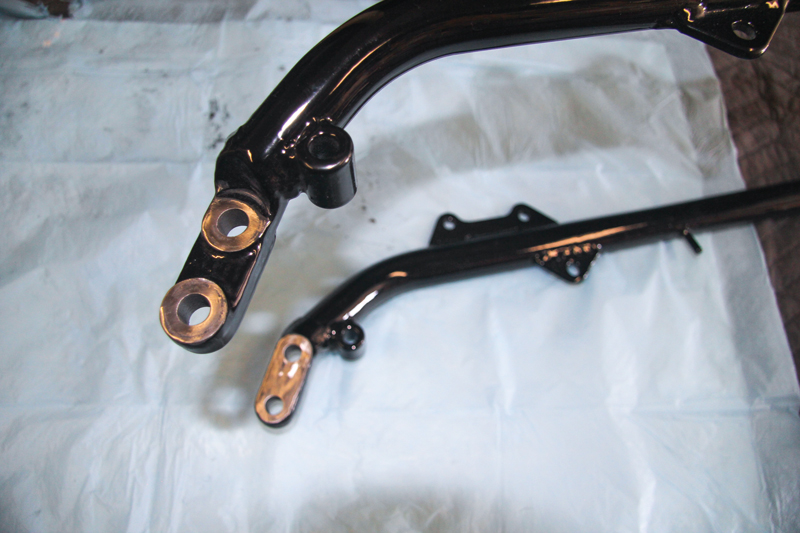
Powder coating is a durable and protective surface treatment that has become ubiquitous in automotive and motorcycle restorations. Applied correctly, it resists UV, moisture and moderate impact. For me as a resto-guy who routinely rides my 1960s Brit bikes, it’s worth the investment.
In a process called electrostatic spray deposition, a specialized spray gun applies electrically charged powder to grounded parts. The parts are then placed in a curing oven, where the coating chemically reacts with heat to form long molecular chains with high cross-link density, making it tougher and more durable than paint.
Unlike paint, powder coating does not rely on a liquid solvent or carrier fluid, so it emits few volatile organic compounds. Applied dry, it can be applied thicker without sagging or running.
Electro Tech Powder Coating in San Marcos, California, did my recent work and owner Adam Mitchell gave me the lowdown on the process and what customers can expect.

First, all grease, oil, dirt and loose rust must be cleaned away. Greasy areas like swingarm abutments, steering necks and chain guards need particular work to avoid risk of porosity failure due to contamination. Some parts will need protection from build-up including threads, tight clearance areas, structural connections, bearing locations, etc. Mitchell insisted that his crew would protect any areas like these.
In the past, I’ve used all-thread rod, assorted washers and even sacrificial bolts to protect crucial areas myself, but Mitchell’s crew are “all car and bike people with years of experience” so I degreased as well as I could and let them protect as necessary with high-heat tape and Teflon plugs.
In house, parts are surface-prepped with an abrasive blast, but excessive grease or oil will contaminate their blast media, so I pressure washed the parts at a car wash to remove the majority of the contamination. Some powder coaters may provide additional cleaning, perhaps baking the parts to burn off greasy residue, but they will charge for that time. Clean parts make everyone happy.
Once the parts are cleaned and prepped, the powder is electrostatically applied. Some parts may get preheated to aid in this application depending on their physical size and thermal mass. Once powder is applied, the parts are oven baked for specific times and temperatures (usually 390 degrees Fahrenheit for 10 minutes), causing the finely milled thermo-plastic powder particles to melt, bond and flow smoothly.

Thickness of application can be critical. Typically, powder coating is a thicker process than painting, so build-up at contact points on frames must be dealt with. I use a 2-inch diameter Scotch-Brite 120-grit pad in a die-grinder to get clean steel-to-steel contact on important areas like swingarm abutments, frame assembly points and any close tolerance areas like steering neck bearing locations. Failure to remove coatings in these areas may lead to vibration-induced fretting and ultimately, a gradual loosening of fastener torque.
Powder is tough to remove and difficult to touch up, so be careful if you want to keep perfect results. Layers of blue masking tape will help to protect that perfect gloss-black finish from errant “whoops” mistakes.
Some through-holes for bolts may need to be chased with an appropriate drill bit. Careful use of a file aids in detailing visible areas. A few threaded holes may need freshly cadmium-plated bolts run in a few times to clear debris. Taps and dies are expensive for arcane Brit bike threads so I use a MacGyver work-around with patience and careful wrenching. I’ve used brass gun-cleaning brushes in a drill motor to clean blind bolt holes.

Useful suggestions to keep the finish fresh include WD-40 to detail the bike once it’s ridden and when it requires cleaning of road grit. It removes road grease without marring the powder, according to Mitchell. I learned to not use my regular brake-cleaning aerosol after an unannounced reformulation caused it to streak the black powder on the 10-year-old restoration of my 1968 Triumph T120 frame.
Simple Green and warm water will remove most dirt with minimal physical abrasion. I avoid scrubbing any powder-coated parts until all grit is removed. It is durable but it can scratch and it can’t be easily polished back. Even chrome will scratch if improperly cleaned, so protect your investment.
“If you wouldn’t use a cleaner on the door of your car, don’t use it on your powder coat,” says Mitchell.
Costs vary depending on the number of parts, amount of handwork and type of finish or specialty colors. Discuss what you want to see and rely on your powder pro to provide it. Treat it well, respect it and it will remain bright and glossy for years.








It’s great that this article explains how this method requires you to clean and prepare the parts before electrostatically applying the powder using a specialized spray gun. If someone wants to use this method, it might help to hire a company that specializes in electrostatic painting. Working with professionals could ensure that the process is done using the correct techniques and equipment so that it’s successful and gives you the best results.
Now I know that powder coating doesn’t use carrier fluid so it’s not runny and dries without those ugly sagging paint build-up. I really need a touch-up on my old car and bicycle since they look rusty already. I might consider this for customizing them but I wonder how this process would go on my car wheels.